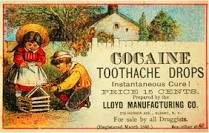








History of Drugs-3
Over the years we have seen a major shift of emphasis. To begin with, natural products were either the raw materials of drugs, or the inspiration for man-made copies. As chemists became more confident, they made cocktails using more and more compounds - some natural, some not.
Nowadays, scientists create chemical cocktails which have little to do with nature as we know it. What effect this will have on our population is still little understood because long-term studies cannot yet be made.
Unlike natural drugs, these chemical cocktails have new molecular arrangements which haven't been on trial for thousands of years. Indeed, their trials are of necessity rather short because a company has to register the thirty-year patent for the new drug before it can carry out trials. The patent is liable to run out if the company doesn't get its act together quickly, and produce the evidence of efficacy and safety required to get a product licence.
The quicker a trial can be done, the more time there is left on the patent in which the company can exclusively exploit its invention. Chemical companies are still interested in nature. In the deepest jungles and the most far-flung corners of the earth, representatives from drug companies continue to score the landscape looking for new varieties of nature to exploit. They are not intending however to manage huge fields of these natural products, and extract from them the drug required. They are simply going to isolate the active substances and replace them in the laboratory.
In their dreams, scientists imagine a future biotechnology when the physiological and psychoactive substances in plants can be produced cheaply and easily, using microbes or whatever. Biotechnology is here however. Take Hirudin, for example, the latest potential drug from Ciba-Geigy Ltd, which is in the human trials stage. The leech Hirudo medicinals was used for centuries to draw blood from patients. The saliva of the leech is now known to contain substances which act as powerful and highly predictable anticoagulant, which may be very useful in the prevention of thrombosis, stroke and heart attack - the Western world's largest killer disease.
The problem is, it takes the salvia from 10'000 leeches to make a single human treatment and, I imagine, it's quite a job! biotechnology, however, gets around the problem by taking the appropriate gene from the leech and putting it in yeast cells, which produce Hirudin molecules. New discoveries continue to be made. In a recent article in the Lancet, co-authored by Noble Laureate B.S.Blumberg, clinical research was presented which proved that the hepatitis B virus was eliminated from the bodies of 59 per cent of people treated for thirty days with dried powdered Phyllanthus amarus, a plant used for over 2,000 years in Ayurvedic medicine to treat liver disease, including jaundice. The plant has also been used in China, the Philippines, Cuba, Nigeria, Guam, East and West Africa, the Caribbean, and central South America.
It's quite a job! biotechnology, however, gets around the problem by taking the appropriate gene from the leech and putting it in yeast cells, which produce Hirudin molecules. New discoveries continue to be made. In a recent article in the Lancet, co-authored by Noble Laureate B.S.Blumberg, clinical research was presented which proved that the hepatitis B virus was eliminated from the bodies of 59 per cent of people treated for thirty days with dried powdered Phyllanthus amarus, a plant used for over 2,000 years in Ayurvedic medicine to treat liver disease, including jaundice. The plant has also been used in China, the Philippines, Cuba, Nigeria, Guam, East and West Africa, the Caribbean, and central South America.
Despite the fact that the plant is used so extensively, and the fact that it has now been studied for over ten years, and has shown no toxic side effects in animals or humans, it will probably never reach the market place in Britain or America. Phyllanthus needs more than the keen advocacy of the eminent Blumberg, who got his Noble prize for discovering the hepatitis B virus and developing the blood test to detect it. Phyllanthus needs tens of millions of pounds to for through clinical testing, and chemical companies aren't going to support that work because to date they have had no intention of selling herbs. They may well look at Phyllanthus, and try to copy its active constituents, but that is another matter.
Reference: Fragrant Pharmacy/ V.Worwood
Read More...History Of Drugs 4
- Home
- Addiction
- JASMINE- Floral - Jasminum Officinale,J. grandiflorum, J.sambac
- History of Drugs-4
- History of Drugs
- History of Drugs-3
- The Somatid Connection
- Rosemary-Personality-Profile
- Personality In Perfumery
- Personality Tests
- Cinnamon - Personality profile
- The Water Connection
- Mind-Mood-Emotion-Quick Reference Chart - S - Un
- History of Drugs-5
- Mind-Mood-Emotion-Quick Reference Chart - Un - W
- Emotional-Healing Problems-A-B-Positive and Negative Mood Charts
- Emotional-Healing Problems-B-H-Positive and Negative Mood Charts
- How Essential Oils Work On the Brain
- Cardamom Personality Profile
- Essential Oils Used For Emotional Healing-A-M
- Lavender- Floral/Herbie
- Positive Mind, Mood & Emotion - Alertness
- Juniper personality profile
- JASMINE- Floral - Jasminum Officinale,J. grandiflorum, J.sambac
- HYACINTH - Floral - Hyacinthus Orientalis
- Emotional Healing Introduction - 2
- Emotional Healing Introduction
- Memory Enhancement, Mental Clarity and Efficiency
- How To Get Through Life In One Piece
- HELICHRYSUM (Immortelle or Italian Everlasting)
- GRAPEFRUIT - Fruitie - Citrus paradisi
- The Art Of Smelling - Which Method - Aromaprofiles
- The Art Of Smelling
- GINGER PERSONALITY PROFILE
- Geranium - Pelargonium graveolens Personality Profile
- Frankincense Resinie - Boswellia Carteri
- Quality and Purity - 2 - AromaProfiles
- Quality and Purity - AromaProfiles
- ChemoTypes - AromaProfiles
- Adaptogens - AromaProfiles
